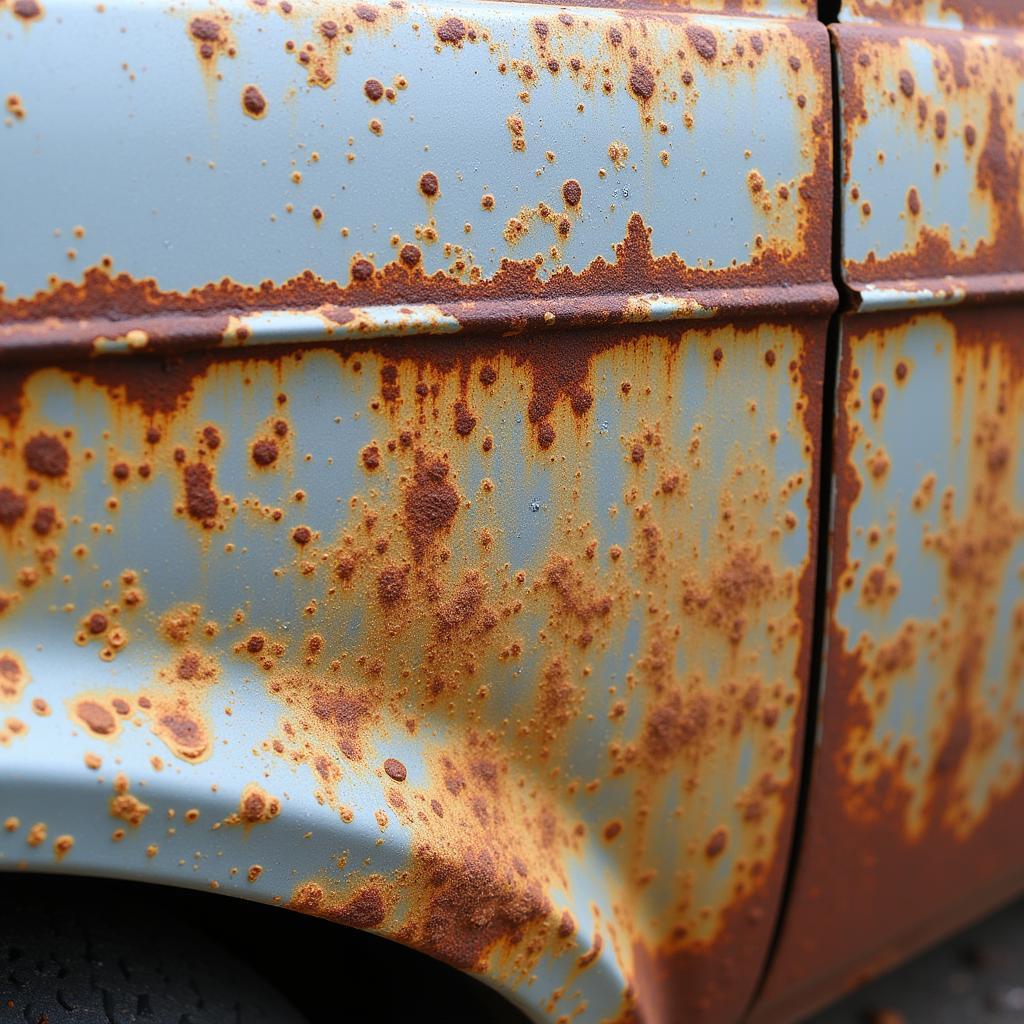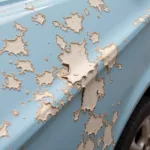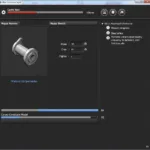Rust on your car is more than just an eyesore; it’s a serious threat to your vehicle’s structural integrity. If left untreated, even a small patch of rust can spread rapidly, compromising the strength of your car’s body and leading to costly repairs. This comprehensive guide delves into the intricacies of car body rust repair and paint, providing you with the knowledge to protect your investment and restore your car’s pristine appearance.
Understanding the Enemy: What Causes Car Rust?
Rust, scientifically known as iron oxide, forms when iron or an alloy containing iron, like the steel used in car bodies, is exposed to oxygen and moisture for an extended period. This electrochemical reaction weakens the metal, causing it to flake, bubble, and eventually deteriorate.
Several factors accelerate the rusting process:
- Exposure to the elements: Rain, snow, humidity, and even salty air near coastal areas create the perfect environment for rust to thrive.
- Road salt: Used in colder climates to melt ice, road salt accelerates rust formation by acting as an electrolyte, speeding up the electrochemical reaction.
- Scratches and chips in the paint: These expose the bare metal underneath, making it vulnerable to the elements.
- Poor drainage: Water pooling in door jams, rocker panels, or under carpets traps moisture, promoting rust development in hidden areas.
Identifying Rust: Early Detection is Key
The sooner you detect rust, the easier and more affordable it is to address. Keep a lookout for these telltale signs:
- Paint bubbles: These small, raised areas on the paint surface indicate that rust is forming underneath.
- Flaking or chipping paint: As rust progresses, it pushes the paint away from the metal surface, causing it to flake or chip.
- Reddish-brown discoloration: This is the most obvious sign of rust and indicates that the corrosion process is well underway.
- Visible holes or pitting: In advanced stages, rust can eat through the metal, creating holes or pits.
Car Body Rust Repair: Stopping Rust in its Tracks
Addressing rust promptly is crucial to prevent further damage. Here’s a step-by-step guide to car body rust repair:
- Assess the Damage: Determine the extent of the rust. Superficial rust might only require sanding and repainting, while severe rust might necessitate cutting out and welding in new metal.
- Prepare the Area: Thoroughly clean the rusted area with soap and water. Then, use a wire brush or sander to remove loose rust and paint.
- Treat with a Rust Converter: A rust converter chemically transforms iron oxide into a stable, paintable surface.
- Apply Body Filler (If Needed): For larger holes or dents, use a body filler to create a smooth, even surface.
- Sand and Prime: Sand the repaired area smooth and apply a primer designed for automotive use. Primer creates a good bonding surface for the paint.
Car Paint After Rust Repair: Restoring the Finish
Once the rust repair is complete, it’s time to restore your car’s finish:
- Choose the Right Paint: Match the paint color precisely to your car’s original finish. Consult your car’s VIN or owner’s manual for the exact color code.
- Apply Multiple Thin Coats: Apply several thin coats of paint, allowing each layer to dry completely before applying the next. This technique ensures a smoother, more even finish.
- Apply a Clear Coat: A clear coat protects the paint from UV rays, scratches, and fading, preserving the vibrancy of the color.
DIY vs. Professional Repair: Making the Right Choice
While minor rust repairs can be tackled by experienced DIY enthusiasts, more extensive damage often requires the expertise of a professional auto body shop. Factors to consider include:
- Extent of the damage: Severe rust, especially if it affects structural components, is best left to the professionals.
- Your skill level and tools: Professional-grade tools and experience are often needed for a seamless repair.
- Time commitment: Rust repair is a time-consuming process, especially if you’re new to it.
- Cost: DIY repairs can save money on labor, but professional repairs often come with a warranty.
Preventing Future Rust: Proactive Measures for Long-Term Protection
Preventing rust from forming in the first place is always easier than dealing with it later. Here are some proactive steps you can take:
- Regular Washing: Wash your car regularly, especially during winter months, to remove road salt, dirt, and grime.
- Waxing: Applying a coat of wax every few months provides a protective barrier against the elements.
- Undercoating: An undercoating treatment helps protect the undercarriage of your car from rust-causing elements.
- Touch-ups: Repair paint chips and scratches promptly to prevent rust from taking hold.
- Garage Storage: Whenever possible, store your car in a garage or carport to protect it from the elements.
Car Body Rust Repair and Paint: Investing in Your Car’s Longevity
Addressing car body rust is not just about aesthetics, it’s about preserving the value, safety, and lifespan of your vehicle. By understanding the causes of rust, recognizing the signs early, and taking appropriate preventive measures, you can keep your car looking its best and maintain its structural integrity for years to come. If you’re unsure about tackling rust repair yourself, don’t hesitate to seek professional help.
FAQs about Car Rust Repair and Paint
Q: Can I drive my car with rust on it?
A: While minor surface rust might not pose an immediate safety risk, it’s crucial to address it promptly. Rust weakens metal, and driving with significant rust damage can compromise the structural integrity of your car, potentially leading to safety hazards.
Q: How much does it cost to repair rust on a car?
A: The cost of car rust repair varies significantly depending on the extent of the damage, the car’s make and model, and labor costs in your area. Minor repairs might cost a few hundred dollars, while extensive rust damage could cost thousands.
Q: Can I prevent rust from coming back after repair?
A: While you can’t entirely eliminate the risk of future rust, you can significantly reduce it. Proper rust repair techniques, followed by proactive prevention measures like regular washing, waxing, and touch-ups, can help protect your car from recurring rust issues.
Need help with car body rust repair and paint? Our expert technicians at [CarRepairOnline] can provide you with the assistance you need. Contact us today for a free consultation.
Don’t let rust take over your car. Take action now and protect your investment. Learn more about [how to repair peeling paint on your car] and explore our resources on [car paint chip repair]. We also offer services in [Melbourne] and [Kelowna] to address your specific car repair needs.



